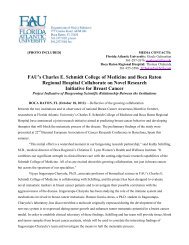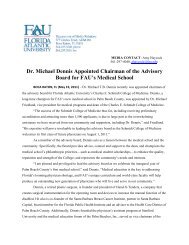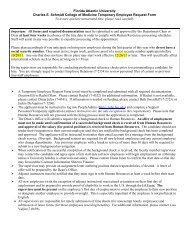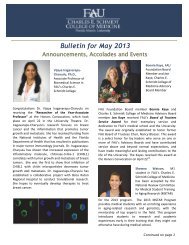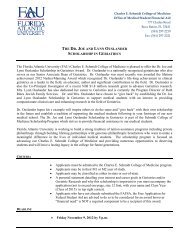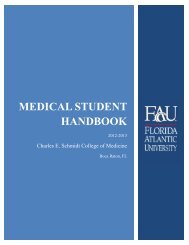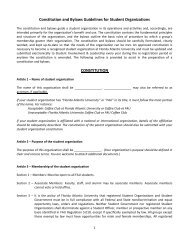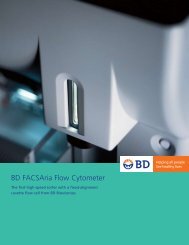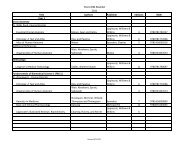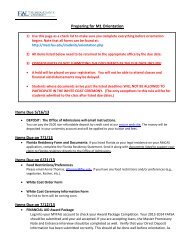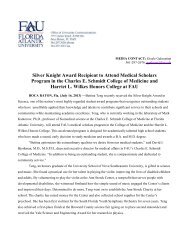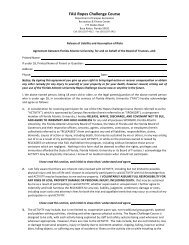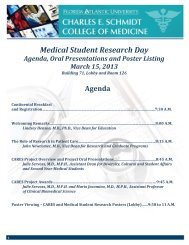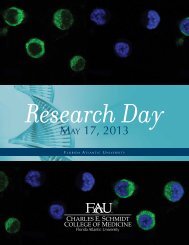Student Handbook - College of Medicine - Florida Atlantic University
Student Handbook - College of Medicine - Florida Atlantic University
Student Handbook - College of Medicine - Florida Atlantic University
Create successful ePaper yourself
Turn your PDF publications into a flip-book with our unique Google optimized e-Paper software.
N L H F E D C Arecommendations for expert panel oversight). Chronically infected HBV-infected health-care providers and studentsare NOT required to: 1) repeatedly demonstrate non-detectable HBV viral loads on a greater than semiannualfrequency; 2) prenotify patients <strong>of</strong> his/her HBV-infection status; or 3) submit to mandatory antiviral therapy. StandardPrecautions should be adhered to rigorously in all health care settings for the protection <strong>of</strong> both patient and provider.Education and TrainingAll students initially receive general information pertaining to the prevention and transmission <strong>of</strong> occupationalexposures during the orientation to the <strong>College</strong> <strong>of</strong> <strong>Medicine</strong>. During this time, students will be required to receiveimmunizations against hepatitis B, meningitis & varicella, and tuberculosis screening if not documented on the historyand physical exam form submitted prior to registration. More formal clinical information about the prevention andpathophysiology <strong>of</strong> all infectious diseases that might potentially be transmitted in a clinical care setting is providedprior to the start <strong>of</strong> clinical clerkships. This would include education regarding hepatitis A, hepatitis B, hepatitis C,varicella, influenza, meningitis, tuberculosis, and HIV.<strong>Student</strong>s will be provided with education on universal blood and body fluid precautions during orientation sessions forfirst year students, and prior to the start <strong>of</strong> the clinical clerkships. <strong>Student</strong>s will also receive information on infectioncontrol and prevention <strong>of</strong> the spread <strong>of</strong> communicable disease. During the first day students are assigned to work ata clinical rotation site, the faculty at the affiliate site will provide information regarding the policies and procedures attheir respective site that students must follow in the event <strong>of</strong> exposure, as described below in “Needlestick Injury andOther Potential Blood-borne Pathogen Exposure”. All students are required to complete training in OSHAand HIPAA:OSHA: http://med.fau.edu/faculty_staff/training.php<strong>Student</strong>s are required to complete two modules: Blood Borne Pathogens and Formaldehyde Use. Successfulcompletion <strong>of</strong> these modules is monitored via the website by the Office <strong>of</strong> <strong>Student</strong> Affairs. No paper documentation isrequired.HIPAA:HIPAA training is given during the week <strong>of</strong> Orientation for first year medical students. Additional HIPAA training isprovided during orientation to the third year <strong>of</strong> medical school.Standard PrecautionsInfection control policies are established for the surveillance, prevention, and control <strong>of</strong> infection caused by a variety<strong>of</strong> microorganisms. These guidelines include definitions, symptoms, mode <strong>of</strong> transmission, as well as prevention andcontrol information. Blood, semen, and vaginal fluids are the three most potentially infectious body fluids but otherbody fluids such as cerebrospinal fluid, synovial fluid, pericardial fluid, peritoneal fluid, amniotic fluid, and unfixedbody tissues should be considered potentially infectious, especially if contaminated with blood. Universal precautionsshould always be followed, even when handling fluids and tissues that are not normally infectious such as saliva,feces, urine, sweat, sputum, vomitus, and tears; it should be noted that these body fluids carry a greater risk <strong>of</strong>infection if contaminated with visible blood, which can result from an accidental occurrence or complication <strong>of</strong> patientcontact and procedures.<strong>Student</strong>s are required to follow appropriate infection control procedures, including the use <strong>of</strong> personal protectiveequipment, whenever there is a risk <strong>of</strong> parenteral, cutaneous, or mucous membrane exposure to blood, body fluids,or aerosolized secretions from any patient, irrespective <strong>of</strong> the perceived risk <strong>of</strong> a blood borne or airborne pathogen.Regardless <strong>of</strong> the real or perceived communicable disease status <strong>of</strong> the patient, all students and staff should followstandard universal precautions when providing patient care. The basic precautions include:Always wash hands before and after patient contact, according to the policy <strong>of</strong> the clinical site, even if glovesare used.37



